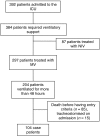Impact of a nurses' protocol-directed weaning procedure on outcomes in patients undergoing mechanical ventilation for longer than 48 hours: a prospective cohort study with a matched historical control group
- PMID: 15774054
- PMCID: PMC1175918
- DOI: 10.1186/cc3030
Impact of a nurses' protocol-directed weaning procedure on outcomes in patients undergoing mechanical ventilation for longer than 48 hours: a prospective cohort study with a matched historical control group
Abstract
Introduction: The aim of the study was to determine whether the use of a nurses' protocol-directed weaning procedure, based on the French intensive care society (SRLF) consensus recommendations, was associated with reductions in the duration of mechanical ventilation and intensive care unit (ICU) length of stay in patients requiring more than 48 hours of mechanical ventilation.
Methods: This prospective study was conducted in a university hospital ICU from January 2002 through to February 2003. A total of 104 patients who had been ventilated for more than 48 hours and were weaned from mechanical ventilation using a nurses' protocol-directed procedure (cases) were compared with a 1:1 matched historical control group who underwent conventional physician-directed weaning (between 1999 and 2001). Duration of ventilation and length of ICU stay, rate of unsuccessful extubation and rate of ventilator-associated pneumonia were compared between cases and controls.
Results: The duration of mechanical ventilation (16.6 +/- 13 days versus 22.5 +/- 21 days; P = 0.02) and ICU length of stay (21.6 +/- 14.3 days versus 27.6 +/- 21.7 days; P = 0.02) were lower among patients who underwent the nurses' protocol-directed weaning than among control individuals. Ventilator-associated pneumonia, ventilator discontinuation failure rates and ICU mortality were similar between the two groups.
Discussion: Application of the nurses' protocol-directed weaning procedure described here is safe and promotes significant outcome benefits in patients who require more than 48 hours of mechanical ventilation.
Figures



Comment in
-
Protocol-directed weaning: a process of continuous performance improvement.Crit Care. 2005 Apr;9(2):138-40. doi: 10.1186/cc3053. Epub 2005 Jan 28. Crit Care. 2005. PMID: 15774063 Free PMC article.
Similar articles
-
Protocol-directed vs. physician-directed weaning from ventilator in intra-abdominal surgical patients.J Med Assoc Thai. 2010 Aug;93(8):930-6. J Med Assoc Thai. 2010. PMID: 20718169 Clinical Trial.
-
Efficacy of weaning protocol in medical intensive care unit of tertiary care center.J Med Assoc Thai. 2005 Jan;88(1):52-7. J Med Assoc Thai. 2005. PMID: 15960217
-
Effect of acute kidney injury on weaning from mechanical ventilation in critically ill patients.Crit Care Med. 2007 Jan;35(1):184-91. doi: 10.1097/01.CCM.0000249828.81705.65. Crit Care Med. 2007. PMID: 17080002
-
Reducing the duration of mechanical ventilation: three examples of change in the intensive care unit.New Horiz. 1998 Feb;6(1):52-60. New Horiz. 1998. PMID: 9508258 Review.
-
[Experience of an intermediate respiratory intensive therapy in the treatment of prolonged weaning from mechanical ventilation].Minerva Anestesiol. 1996 Mar;62(3):57-64. Minerva Anestesiol. 1996. PMID: 8767150 Review. Italian.
Cited by
-
Clinical Application of Modified Burns Wean Assessment Program Scores at First Spontaneous Breathing Trial in Weaning Patients from Mechanical Ventilation.Acute Crit Care. 2018 Nov;33(4):260-268. doi: 10.4266/acc.2018.00276. Epub 2018 Nov 30. Acute Crit Care. 2018. PMID: 31723894 Free PMC article.
-
A knowledge- and model-based system for automated weaning from mechanical ventilation: technical description and first clinical application.J Clin Monit Comput. 2014 Oct;28(5):487-98. doi: 10.1007/s10877-013-9489-7. Epub 2013 Jul 28. J Clin Monit Comput. 2014. PMID: 23892513
-
Defining predictors for successful mechanical ventilation weaning, using a data-mining process and artificial intelligence.Sci Rep. 2023 Nov 22;13(1):20483. doi: 10.1038/s41598-023-47452-7. Sci Rep. 2023. PMID: 37993526 Free PMC article.
-
Development and evaluation of an appraisal form to assess clinical effectiveness of adult invasive mechanical ventilation systems.Scand J Trauma Resusc Emerg Med. 2012 Jul 2;20:45. doi: 10.1186/1757-7241-20-45. Scand J Trauma Resusc Emerg Med. 2012. PMID: 22747895 Free PMC article.
-
Nurse-led weaning protocols-a systematic review and meta-analysis.Front Med (Lausanne). 2025 Aug 1;12:1514287. doi: 10.3389/fmed.2025.1514287. eCollection 2025. Front Med (Lausanne). 2025. PMID: 40823569 Free PMC article.
References
-
- Esteban A, Alia I, Ibanez J, Benito S, Tobin MJ. Modes of mechanical ventilation and weaning. A national survey of Spanish hospitals. The Spanish Lung Failure Collaborative Group. Chest. 1994;106:1188–1193. - PubMed
-
- Kollef MH, Shapiro SD, Silver P, St John RE, Prentice D, Sauer S, Ahrens TS, Shannon W, Baker-Clinkscale D. A randomized, controlled trial of protocol-directed versus physician-directed weaning from mechanical ventilation. Crit Care Med. 1997;25:567–574. doi: 10.1097/00003246-199704000-00004. - DOI - PubMed
Publication types
MeSH terms
LinkOut - more resources
Full Text Sources

